Welcome to our blog post on high-density dragon fruit plantations! This article will explore various aspects of this fascinating fruit cultivation method, including spacing, plants per acre, techniques, cost, and yield. High-density planting is a modern approach that maximizes land utilization and optimizes productivity. We can accommodate more plants per acre by carefully spacing the dragon fruit plants, resulting in higher yields.
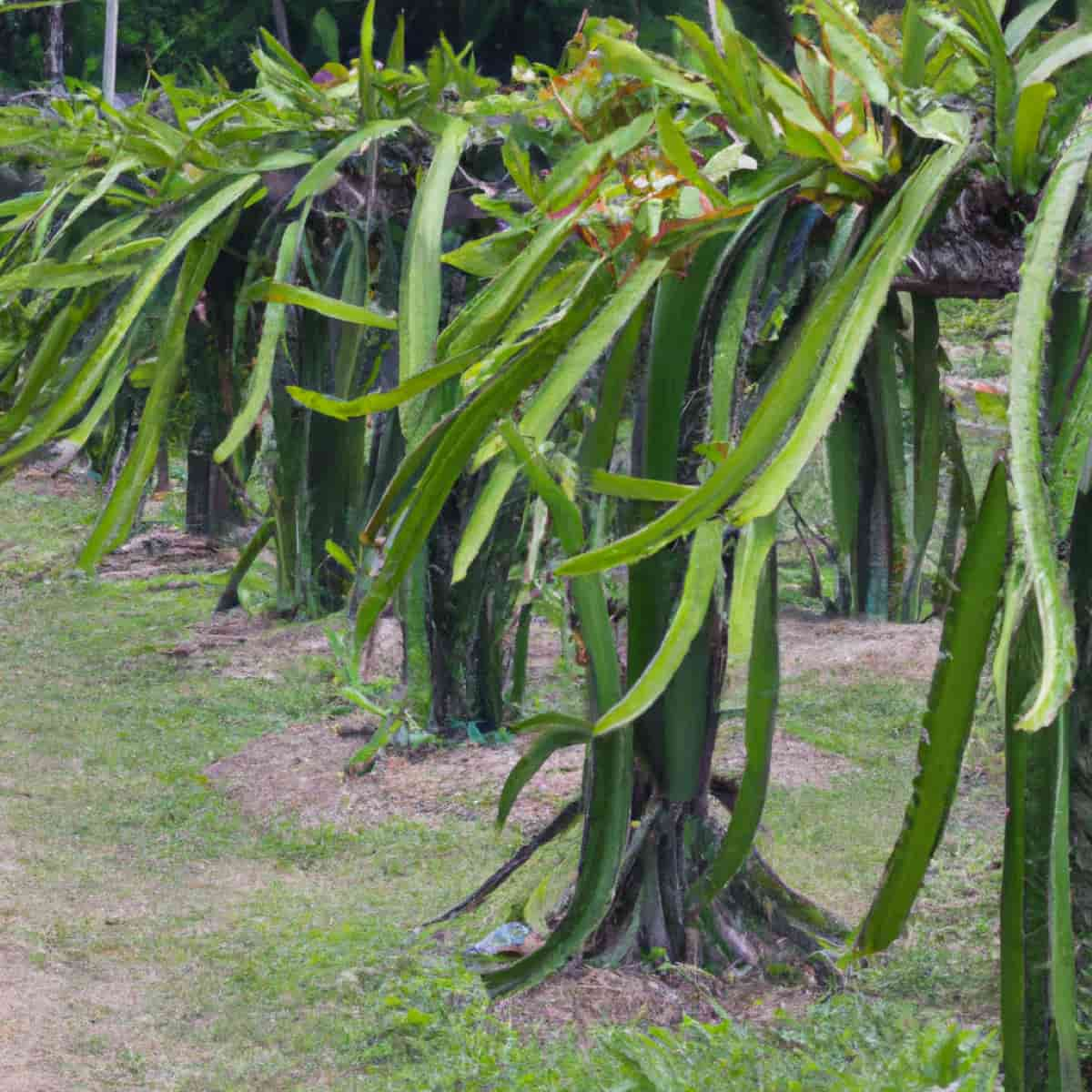
The key lies in employing advanced techniques such as trellising and pruning to create a vertical growth system, allowing plants to flourish in a limited space. While the initial setup cost may be slightly higher due to the required infrastructure, the long-term benefits outweigh it. We will delve into the nitty-gritty of this method, giving you a comprehensive understanding of high-density dragon fruit plantations. Let’s get started!
High-Density Dragon Fruit Plantation
What is High-Density Dragon Fruit Plantation?
High-density dragon fruit plantation is a modern cultivation method that maximizes land productivity by strategically spacing the plants. It involves planting a higher number of dragon fruit plants per acre compared to traditional methods. Scientifically designed spacing allows for efficient land utilization and increased yield potential. Techniques like trellising and pruning create a vertical growth system, enabling optimal plant growth in a limited space. This method requires careful planning and management, but it offers significant advantages in increased productivity and profitability.
Benefits of High-Density Dragon Fruit Plantation
- Increased yield: High-density planting allows for more plants per acre, leading to higher overall yield. Studies have shown that yields can increase by up to 30% compared to traditional planting methods.
- Space utilization: Using vertical growth systems, high-density plantations optimize land usage, making it ideal for small or limited spaces. It maximizes the number of plants that can be grown in a given area.
- Enhanced pollination: The proximity of dragon fruit plants in high-density plantations promotes cross-pollination, resulting in improved fruit sets and higher-quality yields.
- Disease control: Proper spacing and air circulation in high-density plantations reduce the risk of disease spread, leading to healthier plants and decreased need for chemical interventions.
- Efficient harvesting: Compact plantation layouts in high-density systems facilitate easier access to the fruit, simplifying the harvesting process and reducing labor costs.
- Improved fruit quality: With optimized spacing, plants receive adequate sunlight, nutrients, and water, improving fruit quality, size, and taste.
- Sustainability: High-density plantations promote resource efficiency by reducing water usage, fertilizer requirements, and land consumption, making it an environmentally friendly choice.
- Economic viability: Despite the initial setup costs, high-density dragon fruit plantations can generate higher profits due to increased yields and optimized land utilization, making it a financially rewarding endeavor.
In case you missed it: Growing Dragon Fruit In Pots, Containers, Backyards
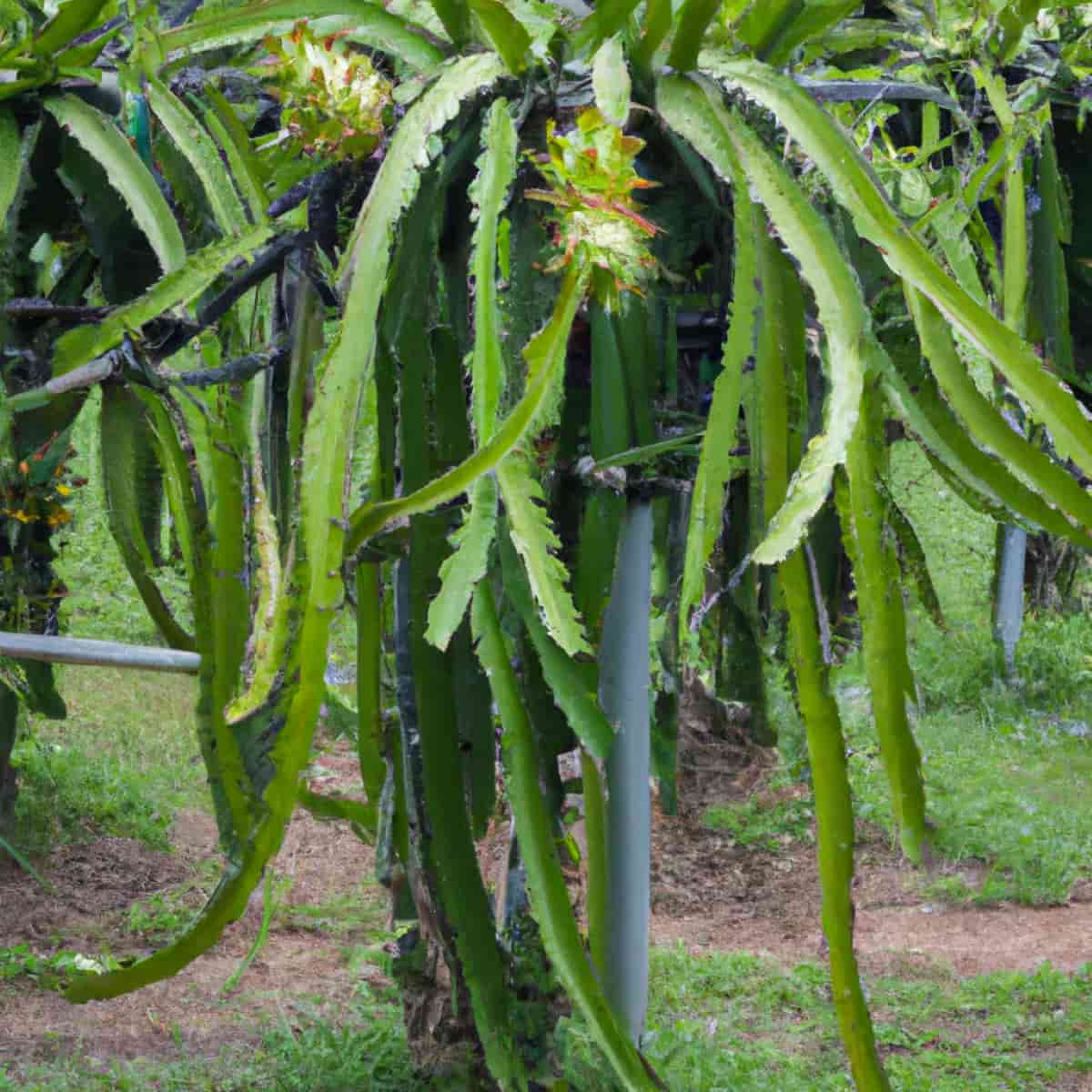
High-Density Dragon Fruit Plantation Techniques
When it comes to high-density dragon fruit plantation techniques, there are several factors to consider for successful growth. Successfully cultivating dragon fruit in a high-density plantation have higher profits and yield.
Choosing between seeds and cuttings: The choice between dragon fruit seeds and cuttings depends on the time you’re willing to invest. Growing from seeds can take around two years before the plant bears fruit while using cuttings from an existing plant can significantly reduce the waiting time.
Planting location: Dragon fruit can thrive outdoors and indoors in containers and open fields. If using a container, opt for one 15″ to 24″ in diameter and at least 10″ deep, with a climbing pole for support. Select a partly sunny spot for outdoor planting where the plant’s tips can receive sunlight for optimal blooming. In colder regions, bring the plant indoors during winter.
Soil requirements: Dragon fruit plants prefer well-drained, sandy cactus soil. Avoid wet or muddy soil and ensure water doesn’t pool around the plants. Planting on a hill or mound can facilitate water drainage in areas with high rainfall.
Planting and care: If using cuttings, allow them to dry in a cool, shady area for about a week before planting. Plant them in full sun, flush with the soil line. For seeds, sow a few in each container and lightly cover them with soil. Consider adding a small amount of slow-release fertilizer for faster growth.
Fertilization and watering: Dragon fruit plants require occasional fertilization, but excessive use can harm them. Apply a low-nitrogen cactus fertilizer every two months. Water the plants sparingly, allowing the soil to dry out between waterings. Proper drainage is crucial to prevent overwatering.
Pruning and harvesting: Prune the plant when it becomes too large by cutting off branches, which can be used to grow new plants. Dragon fruit typically bears ripe fruit in late summer or fall, indicated by a red or yellow skin that is slightly soft when squeezed. Enjoy the sweet, crunchy texture of the fruit, and anticipate multiple fruit-bearing cycles per year once the plant reaches full production.
High-Density Dragon Fruit Plantation Varieties
- Hylocereus undatus: Also known as the white-fleshed dragon fruit, it has a vibrant pink exterior and white, sweet flesh. It is one of the most common varieties grown worldwide and is favored for its refreshing flavor.
- Hylocereus polyrhizus: This variety, commonly called the red-fleshed dragon fruit, features a vibrant red or magenta interior. It has a slightly sweeter taste compared to the white-fleshed variety and is visually striking.
- Hylocereus costaricensis: Known as the yellow dragon fruit, this variety has a bright yellow exterior and unique, tangy-sweet flavor. It is often preferred for its distinct taste and attractive color.
- Selenicereus megalanthus: The yellow dragon fruit, or “Pitahaya Amarilla,” stands out with its yellow skin and white flesh. It offers a sweet and tart flavor, similar to a combination of kiwi and pear.
- Hylocereus hybrid varieties: Numerous hybrid dragon fruit varieties combine different traits and flavors. These hybrids offer various colors, including purple, pink, and yellow, with varying tastes and textures.
In case you missed it: Frequently Asked Questions About Dragon Fruit Farming
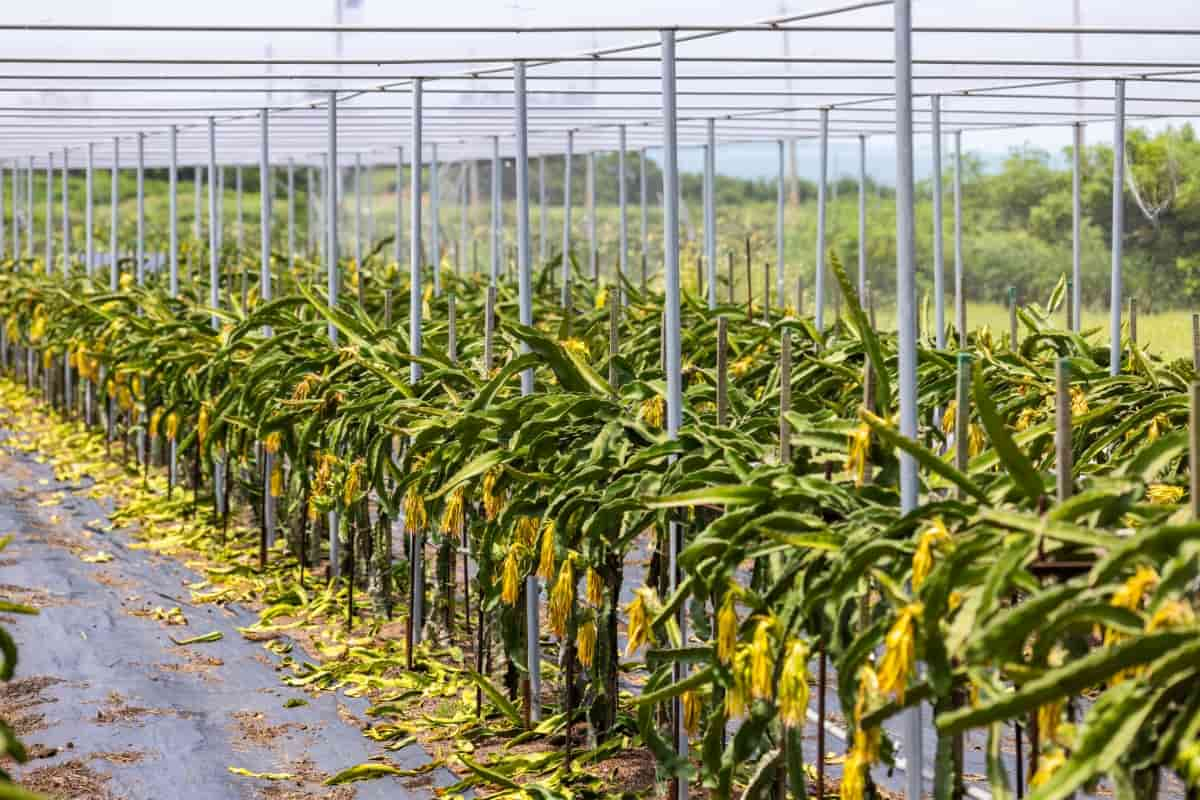
Increasing Yield in High-Density Dragon Fruit Plantation
To increase yield in high-density dragon fruit plantations, optimizing spacing, implementing trellising and pruning, encouraging cross-pollination, practicing nutrient management, ensuring proper water management, and implementing pest and disease control measures are key. These methods promote better light penetration, air circulation, nutrient uptake, and fruit set, leading to higher yields. Strategic pruning helps balance growth, while cross-pollination enhances productivity. Implementing well-balanced fertilization, proper irrigation, and integrated pest management support plant health and productivity
Sustainable and Best Practices for High-Density Dragon Fruit Plantation
Climate: Dragon fruit can tolerate extreme temperatures and poor soils but thrives best in a tropical climate with 40-60 cm annual rainfall. The ideal temperature range for growth is 20°C-30°C.
Soil Requirement: Dragon fruit can be grown in various soils, but sandy soils with good irrigation are preferred. The soil pH range be between 5.5 and 6.5 for optimal growth. Raised beds of 40-50 cm in height are recommended.
Planting: Two methods of growing dragon fruit are using seeds or cuttings. Seeds require three years of growth before being usable, so most farmers opt for cuttings. Cuttings should be around 20 cm long, taken from the mother plant, and left in the shade for 5-7 days before planting.
Plant Spacing: The distance between dragon fruit plants depends on the support system used. The distance should be 2-3 meters for vertical support, while for horizontal support, it can be reduced to 50 cm, enabling intensive farming. Vertical supports should be 1-1.20 meters high, while horizontal supports should be 1.40-1.60 meters high.
Pest Treatment: Treat the land with fertilizers in mounds, using 20 kg of organic fertilizers, 0.5 kg of superphosphate, and 1 kg of NPK16-16-8 per 50 plantings before actual planting. During the first year, apply 50 grams of urea and 50 grams of phosphate thrice.
Irrigation: Dragon fruit requires less water, so irrigation once a week is recommended. Drip irrigation is preferred for better efficiency.
Harvesting: Dragon fruit takes 27-30 days to grow fully. Harvest the fruit as soon as it reaches full size; even a 4-5 days delay can lead to rot. The expected yield per hectare can range from 10 to 30 tons, depending on conditions and techniques. To harvest, twist the fruit clockwise and pluck it.
In case you missed it: Dragon Fruit Farming Profit, Cost, Yield, Project Report
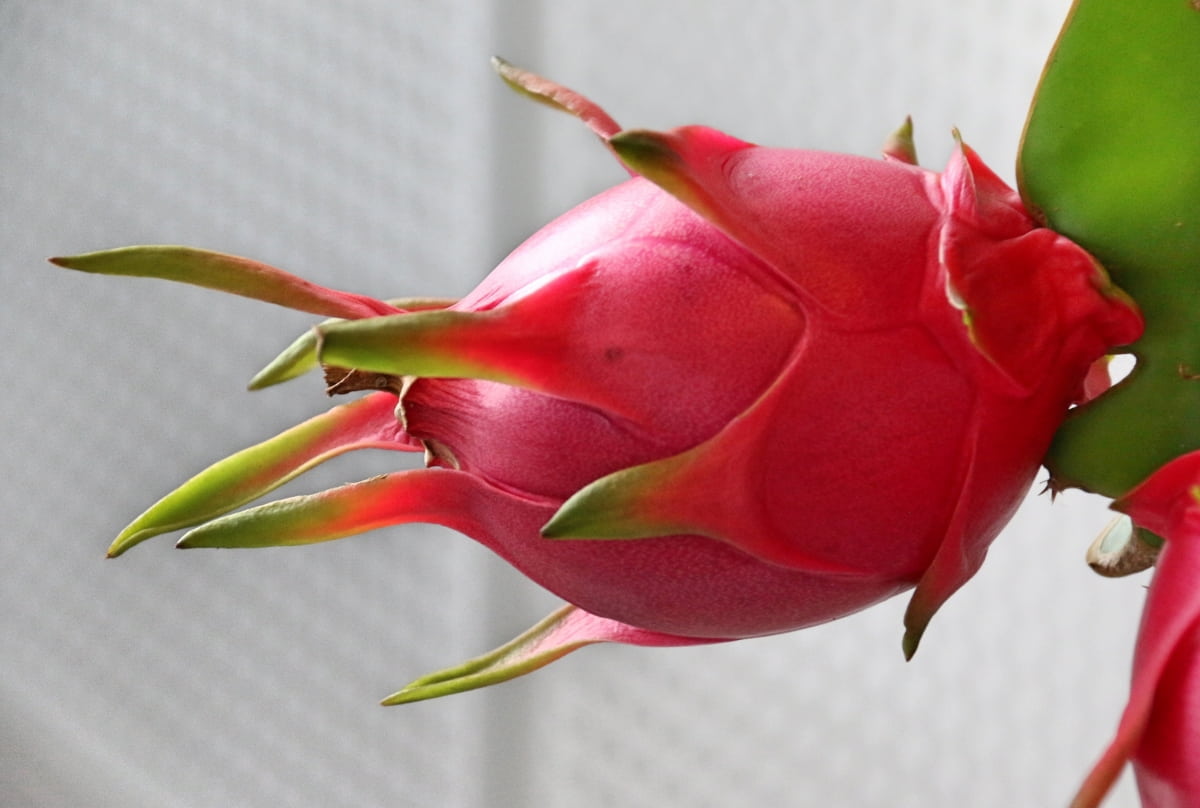
High-Density Dragon Fruit Plantation Spacing
High-density dragon fruit plantation spacing involves propagation from cuttings. The plants thrive in warm areas with well-drained, composted soil and rainfall ranging from 400 mm to 1,500 mm per year. Managing up to 2,800 plants per acre is feasible with pole spacing options of 2m x 2m, 2.5m x 2.5 m, 4 m x 2.5 m, and 5 m x 2.5 m, depending on the trellising system each pole 3-4 plants.
The thick stems can grow up to 4 m in a single season and should be trained onto a pole or trellis system around 1.8 m high. Precast concrete poles are commonly utilized, with three to four plants trained on each pole.
Optimal Fertilization for High-Density Dragon Fruit Plantation
Optimal fertilization for high-density dragon fruit plantations varies based on soil and location. During plantation, applying 10-15 kg of FYM or organic manure and 100 g of SSP per plant is recommended. In the first two years, each plant requires approximately 300 g of N, 200 g of P, and 200 g of K annually.
For mature plants, 540 g of N, 720 g of P, and 300 g of K should be given in four equal split doses at a 3-month interval. Water and nutrient management should consider regional-specific practices, while weed management involves herbicide applications, intercropping, and suitable equipment for intercultural operations.
Pollination of High-Density Dragon Fruit Flowers
Pollination of high-density dragon fruit flowers primarily occurs naturally through nocturnal pollinators such as bats and moths. However, hand pollination has sometimes been found to increase fruit size. In South Africa, bees play a significant role in pollinating dragon fruit flowers.
In case you missed it: Earning 12 Lakh from Dragon Fruit Cultivation: A Success Story of a Farmer in India
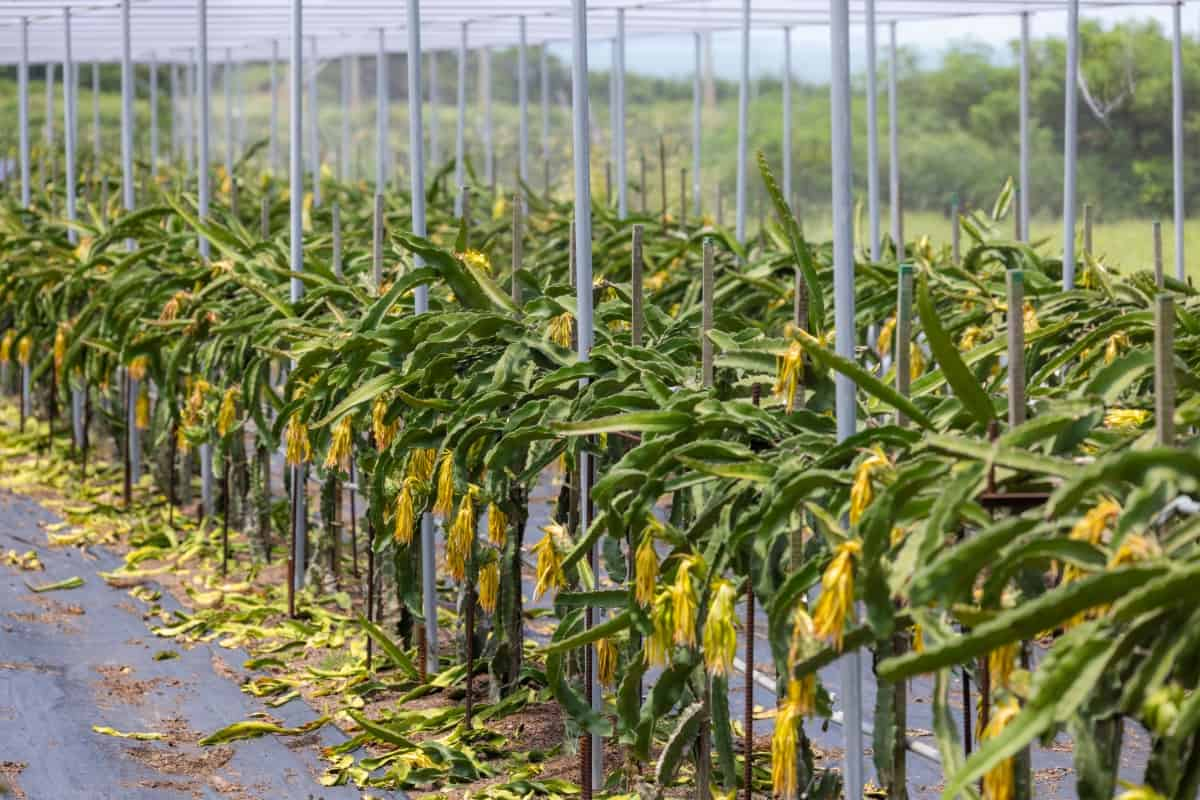
The flowers open at 18:00 and remain open until 11:00 the next morning, providing bees ample time to gather pollen from the large 30 cm flowers containing approximately 100 g of pollen. Combining dragon fruit cultivation with bee farming can be a beneficial approach to enhance pollination. Artificial lighting can stimulate flowering, although its practicality and cost may vary in different regions.
High-Density Dragon Fruit Plantation Pruning Methods
Pruning methods for high-density dragon fruit plantations are not widely adopted, particularly during the first five years of growth. However, after this initial period, canopy management becomes essential to facilitate intercultural operations and achieve higher yields. The thorny nature of the crop and its growth pattern in dryland areas pose challenges to implementing standard canopy management practices.
Research is needed to address issues such as pole and wire collapse due to the increasing weight of the canopy in older orchards. Proper canopy management helps maintain an umbrella-shaped plant structure for effective sunlight interception. Different trellising systems, including single poles with concrete or iron rings, continuous pyramid stands, T-stands, and wooden ladders, support the fast-growing vines and prune lateral stems. Concrete poles with concrete rings buried in the soil are commonly used.
Managing Pests and Diseases in High-Density Dragon Fruit Plantations
Dragon fruit is generally resistant to pests, diseases, and disorders, but it’s important not to become complacent about protecting dragon fruit orchards. Common pests like ants, nematodes, scale insects, and mealybugs can be controlled with insecticide applications. Similarly, fungal and bacterial pathogens, such as anthracnose, brown spots, stem rots, and stem canker, can affect dragon fruit yield and quality.
Excess light, sunburn, and calcium deficiency can exacerbate diseases, so timely detection and precautions are necessary. Fruit flies like Bactrocera dorsalis and Bacrocera correcta have been reported in India, causing yield losses of up to 35%. Disorders related to water and soil nutrient imbalance and extreme climatic conditions can also affect dragon fruit, resulting in size, shape, color, and taste changes.
Predators like rats and birds pose a threat to ripening dragon fruit, causing losses of 5-8%. Netting is recommended to prevent damage. Standardization and implementation of integrated pest and nutrient management practices are crucial for enhancing yield and productivity in dragon fruit orchards.
High-Density Dragon Fruit Plantation Harvesting Tips
When the skin turns red, dragon fruits are harvested 30-35 days after flowering. Manual harvesting using sickles, cutters, and pickers is common in India, but improved tools are needed. Cleaning, sorting, and grading are done manually based on size, color, and weight. Standardizing post-harvest practices is important to address physiological disorders and bacterial and fungal diseases and minimize losses.
In case you missed it: How to Grow Dragon Fruit from Scratch: Check How this Farming Guide Helps Beginners
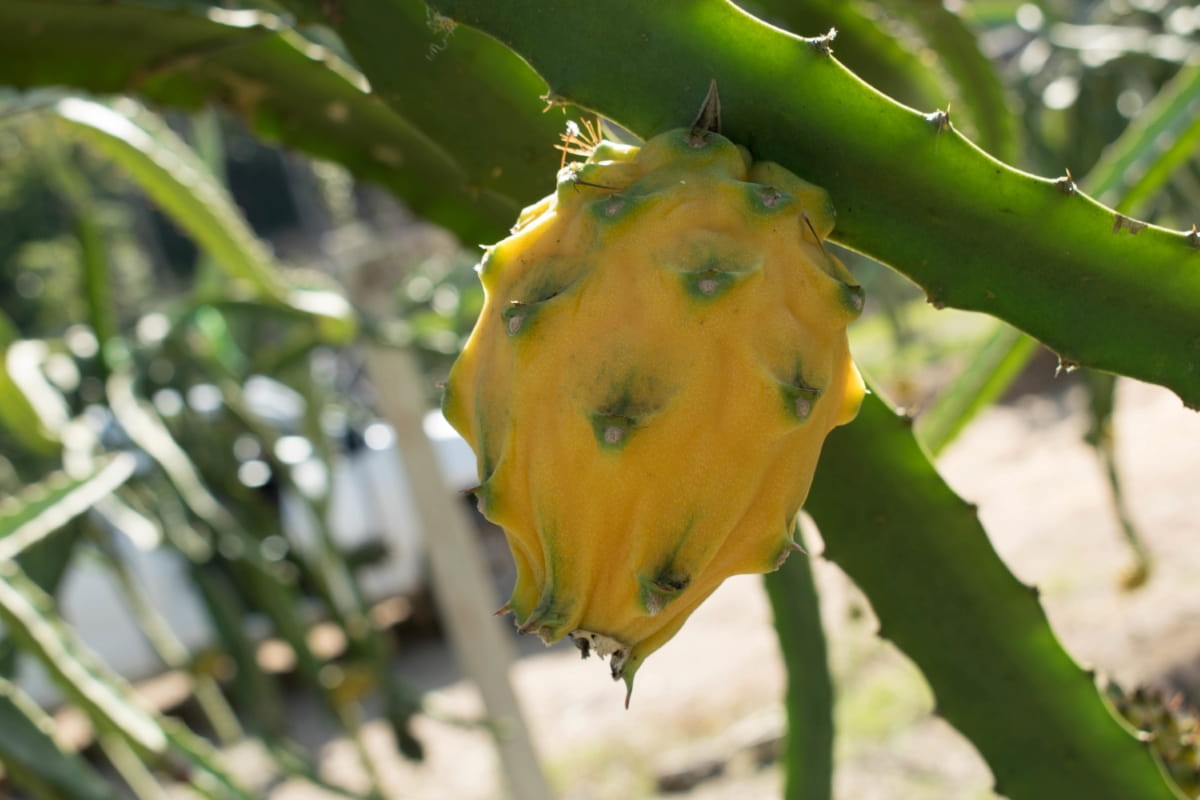
Precooling, heat treatment, controlled storage, and proper transportation are key. Dragon fruit can be processed into value-added products. Standardization, improved facilities, and marketing guidelines are needed for effective post-harvest management.
Dragon Fruit Plantation Cost Analysis (1 Acre Basis)
Dragon fruit plantation on a one-acre basis involves a spacing of 12 feet between rows and 6-8 feet between each plant, accommodating around 1800-2500 plants. The cost of each plant ranges from 50-120 Rs, with an average price of 80 Rs. Poles, the most significant investment, can cost up to 500 Rs per pole, with an average price of 480 Rs. The total cost for poles can range from 2-3 Lakh rupees.
Other expenses, including labor, fertilizers, and drip irrigation, are relatively nominal. The initial investment in the first year is around 5-6 Lakh rupees, while subsequent years’ expenses do not exceed 1 Lakh rupees yearly. In terms of returns, the first-year yield is minimal, around 500 kg per acre.
From the second year onwards, a nominal yield of 20 kg per pole can be expected. The gross income varies based on the selling price per kilogram of dragon fruit. Profitability is achieved from the second year onwards with a selling price of 100 Rs per kg. If the selling price is 50 Rs per kg, profitability is achieved from the third year onwards.
Note: The cost of cultivation for traditional dragon fruit plantations and high-density plantations differs mainly in plant density and pole requirement. High-density plantations require closer spacing, resulting in higher plant and pole costs. However, the increased yield potential in high-density plantations can offset the initial investment and lead to higher profits in the long run.
Conclusion
High-density dragon fruit plantations utilize closer spacing and accommodate more plants per acre, employing advanced cultivation techniques. Although the initial costs may be higher, the increased plant density leads to higher yields, making high-density plantations a profitable choice in the long term.
- Types of Pesticides Used in Agriculture: A Beginner’s Guide
- Economical Aquaculture: A Guide to Low-Budget Fish Farming
- 15 Common Planting Errors That Can Doom Your Fruit Trees
- How to Make Houseplants Bushy: Effective Tips and Ideas
- Innovative Strategies for Boosting Coconut Pollination and Yield
- Pollination Strategies for Maximum Pumpkin Yield
- The Complete Guide to Chicken Fattening: Strategies for Maximum Growth
- Natural Solutions for Tulip Problems: 100% Effective Remedies for Leaf and Bulb-Related Issues
- Revolutionizing Citrus Preservation: Towards a Healthier, Greener Future
- Natural Solutions for Peony Leaf and Flower Problems: 100% Effective Remedies
- Maximizing Profits with Avocado Contract Farming in India: A Comprehensive Guide
- Natural Solutions for Hydrangea Problems: 100% Effective Remedies for Leaf and Flowers
- The Ultimate Guide to Choosing the Perfect Foliage Friend: Bringing Life Indoors
- From Sunlight to Sustainability: 15 Ways to Use Solar Technology in Agriculture
- The Ultimate Guide to Dong Tao Chicken: Exploring from History to Raising
- The Eco-Friendly Makeover: How to Convert Your Unused Swimming Pool into a Fish Pond
- Mastering the Art of Delaware Chicken Farming: Essentials for Healthy Backyard Flocks
- 20 Best Homemade Fertilizers for Money Plant: DIY Recipes and Application Methods
- How to Craft a Comprehensive Free-Range Chicken Farming Business Plan
- Brighten Your Flock: Raising Easter Egger Chickens for Beauty and Bounty
- How to Optimize Your Poultry Egg Farm Business Plan with These Strategies
- Subsidy for Spirulina Cultivation: How Indian Government Schemes Encouraging Spirulina Farmers
- Ultimate Guide to Raising Dominique Chickens: Breeding, Feeding, Egg-Production, and Care
- Mastering the Art of Raising Jersey Giant Chickens: Care, Feeding, and More
- Ultimate Guide to Raising Legbar Chickens: Breeding, Farming Practices, Diet, Egg-Production
- How to Raise Welsummer Chickens: A Comprehensive Guide for Beginners
- How to Protect Indoor Plants in Winter: A Comprehensive Guide
- Ultimate Guide to Grow Bag Gardening: Tips, Tricks, and Planting Ideas for Urban Gardeners
- Guide to Lotus Cultivation: How to Propagate, Plant, Grow, Care, Cost, and Profit
- Agriculture Drone Subsidy Scheme: Government Kisan Subsidy, License, and How to Apply Online
- Ultimate Guide to Raising Araucana Chickens: Breed Profile, Farming Economics, Diet, and Care
- Bringing Hydroponics to Classroom: Importance, Benefits of Learning for School Students
- Ultimate Guide to Raising Polish Chickens: Breed Profile, Farming Economics, Diet, and Care
- Ultimate Guide to Raising Australorp Chickens: Profile, Farming Economics, Egg Production, Diet, and Care
- Silkie Chicken Farming: Raising Practices, Varieties, Egg Production, Diet, and Care
- Sussex Chicken Farming: Raising Practices, Varieties, Egg Production, Diet and Care